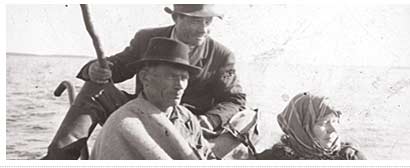|
|
The Inari Sámis moved each year (“várristâllâm” in Inari Sámi) to a great extent up until the Second World War. And then it was mostly between two places: one in the summer and one in the winter. The notes of T. I. Itkonen, Ilmari Itkonen and Samuli Paulaharju from the beginning decades of the last century relate that their moves also included more stages. There were evidently up to six different abodes lived in on their route. The head of one family that moved in this fashion once said that it was easier to move a large family from place to place than to provide for and transport the food from hunting grounds and fishing waters to one abode.
The locations of summer and winter abodes of course had an effect on ancestral living areas in Inari. Summer places were situated on the shores of Lake Inari – either on open peninsulas or islands, but people lived had such places on the shores of other large lakes as well.
Winter abodes were chosen from protected places in forest areas close to winter grazing areas for reindeer. Another consideration was the availability of wood used in making flour from bark. Some had security in mind and wanted the winter residence to be hidden well within the surrounding wilderness.
”Várristâllâm” Continued After the First Homesteads
When ancestral living area became homesteads they often incorporated both the summer and winter places, thus “meandering” continued even after the founding of the homestead. The distance between summer and winter places was not often more than five kilometers. The one of the practical reasons for this was perhaps that the summer homes were spacious, well-built and the yard contained various kinds of buildings. When in the 1800s the Inari Sámis adopted the keeping of cattle from the newly-settled Finns, it was necessary to build shelters for the domestic animals in both summer and winter homes. Both places were equipped with the most essential household belongings.
Moving was often embarked upon during the last favorable conditions but the small-scale agriculture incorporated into their lifestyle sometimes delayed them so much that potatoes got to be sown even at the winter homes. During the last decades, the 1950s and 1960s, the move to the summer homes did not occur until the children got out of school for their summer vacations. If water routes could be traveled for the move, the heavier things were taken by boat and often small children as well. The womenfolk traveled overland with the cattle and the older children.
Close to the Catch
Potatoes and other vegetables were grown for the summer at the summer places as well. The chief reason for making the move was to get closer to better hunting and fishing areas. Spring fish were dried in windy places while fish caught in the autumn were preserved for the winter by salting it. At the summer place hay was grown, cut and dried; lake grass and lichen were also harvested there. In winter conditions foodstuffs preserved for the winter as well as cattle and reindeer feed were taken from summer homes and nearby caches whenever needed.
Inari Sámis from the Partakko area have moved between summer and winter abodes up until the 1970s and the last until the beginning of the 2000s. Since the movement to concentrated centers of populations, homes in the more isolated villages have remained in the families and kept as summer places up to today.
Irja Jefremoff
|
|
| Inka Sarre baking a cake on flagstone. Inari Sámis began to live in cabins at the end of the 1700’s. Väinö Auer 1918. |
|
|
| The summer home of the Saijets family. Nuoran-Juhani on the shore of Lake Inari. T.I. Itkonen 1902. |
|
| The winter home of Sammeli Sarre’s family Talvitupalompolo. |
|


![]()

